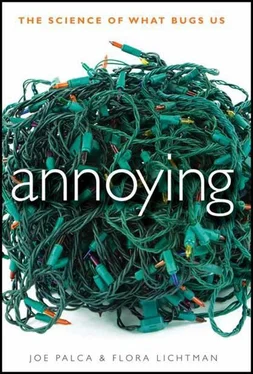Robert Zatorre, a cognitive neuroscientist who studies perfect pitch at the Montreal Neurological Institute, gives this analogy for how people with perfect pitch hear the world: “It’s like if I see a cat or a dog. When I was a child, I didn’t know what they were called, but I knew a cat was a cat when I saw one and a dog was a dog when I saw one. Someone eventually told me the label for that creature is cat .” For people with perfect pitch, the difference between an A flat and a C sharp is the difference between a cat and a dog.
Some have used colorblindness to help explain what it’s like for those of us without perfect pitch—but Zattore doesn’t think this is quite right. If you can see color, a particular hue probably doesn’t have a distinct identity. For example, try to match the color of your wall from memory when you’re at the paint store. “You try that and see how successful you are when you get back home. It’ll be off, there’s no question. Why is that? Because we don’t have absolute color. If we had absolute color, we’d be able to look at that wall and say, ‘Okay, I know the exact shade that is.’ And I could go to the paint store and pick that one out of the thousands of possible shades that might exist. There may actually be people who have something like absolute color, and maybe they’re artists or interior decorators, I don’t know.”
For Lucy, each pitch does have a unique identity—and this may explain why an out-of-tune note is so annoying. “They sort of have different characters or textures to them in my head now,” she says. “And I associate them in groups of fifths.” A fifth would be two notes that are seven semitones apart—that’s the number of notes, including sharps and flats, between two notes. Lucy associates A and E, F and C, and D and G. In terms of frequencies lining up, they are the next most perfect interval to an octave. (A fifth is more familiar to your ear as a power chord, the building blocks of rock music for bands that range from the Kinks to the Kings of Leon.) “I hear them sort of in these pairs of fifths with similar textures to them, if you will. This sounds kind of weird—F and C are sort of like flat and ribbonlike. Like a flat, smooth ribbon. And A and E are more like a single strand. But D and G to me sound more rich, softer. Like a fuzzy ribbon.”
Lucy doesn’t see a fuzzy ribbon in her brain, she says, she feels it. “Like if my brain had fingers, it could feel these notes, and that’s what they would feel like. It seems like everyone should feel this way, too, because they are all different, they’re all their own unique selves. You don’t exactly think about it; it’s just how they are. It’s like they’re all individual different people or something like that. And they all have different characteristics.”
For her, when a note is out of tune, it doesn’t have an identity. “Maybe what makes it annoying, when the pitch is in this nebulous area between two notes, is that it’s in no-man’s-land.” There is something unsettling about an unidentifiable signal. It’s irritating to hear something that we can’t place.
Out-of-tune sounds bother her because her brain is expecting a tone to sound a certain way. David Ross puts it like this: “A similar phenomenon exists in psychotherapy.” (When he’s not doing perfect-pitch research, he’s a psychiatrist treating patients with post-traumatic stress disorder at the Veterans Administration.) “If you’re feeling frustrated at any point in time, it’s because there’s a gap in expectation. If you’re frustrated with a patient, it’s because your expectations of what’s going to happen don’t match with what the patient’s expectations are. If you have somebody who is drinking, he keeps drinking and you get really frustrated. It’s your problem, not his problem. He doesn’t want to stop drinking. Once you adjust your expectations, everything is fine. If your expectation is that the notes will be perfect, you’re going to be disappointed.”
As someone who is interested in how music has changed over history, Lucy is acutely aware of this. “It’s definitely a construct that’s occurring within this artificial system that we’ve created in Western tonal music.”
Now that you know all of this about Lucy, you may be shocked by what her particular focus is: early music, which is particularly grating for someone with perfect pitch. You see, compositions from the 1600s, for example, are not tuned to the same standard as modern tuning. An A from that era is not the same frequency as an A today. (This is called having a difference in pitch center.) “Growing up in the modern world, we think of the note A as being at 440 Hz. And a lot of early music does A at 415, which is a half-step lower, or A at 465, which is a half-step higher, in which case I have to transpose.”
In addition, early music often has a different “temperament” than today’s equal temperament. This is basically how notes are shoehorned into an octave. The relationship between a D and a G might be different, frequency-wise, in one temperament than in another. In early music, one of the tuning systems used is called quarter-comma meantone. “The tuning system itself changes where I expect pitches to be. For me, the most annoying part is that the fifths are lower than in equal temperament, so to me they sound flat.” Lucy says that this can make for good tonal symbolism, though. The out-of-tune sound conveys anguish.
For a singer with perfect pitch, that anguish is visceral. “I feel like I have to sing out of tune,” says Lucy. “It isn’t really out of tune, it’s just a different way of thinking about music. I’m sure for people back then who had perfect pitch, that would have been completely normal to them. It does highlight how much of this is artificial—is really just a construct of our brains.”
The annoying part is a construct: the product of learning a musical system and then expecting the sounds you hear to fit within it, which suggests an extrinsic unpleasantness. On the other hand, if you are musically trained and have perfect pitch, there may be no situation in which an out-of-tune note isn’t annoying, which suggests an intrinsic unpleasantness—at least, for this population.
Who is at risk for this special annoyance? There’s a lot of debate about that—particularly about the role of musical training in developing perfect pitch. Lots of musicians had early musical training, but most don’t have perfect pitch. On the other hand, most people who have been identified as having perfect pitch have had early musical training. What David Ross wants to understand is whether you can have perfect pitch with no musical training.
Lucy grew up in a musical house, although she’s the only one with perfect pitch. She started on the violin when she was five, but she doesn’t remember always hearing the world the way she does now. She began singing in the choir in junior high. “It was really strange. I remember one time I sang a wrong note, and one of the girls sitting next to me was like, ‘Lucy makes mistakes!’ and I was like, ‘Of course, I make mistakes. Everyone makes mistakes.’ But then I started thinking about it and realized that I really did always know what the pitches were going to be. I don’t think I was born with perfect pitch. And I really didn’t notice it until I started singing.”
The debate about whether absolute pitch is learned or something you are born with has raged in the scientific literature for longer than a hundred years, Ross says. He hopes his research will someday help resolve the debate.
Most perfect-pitch tests go something like this. A researcher—or, more likely, a graduate student—will play a series of notes and ask the listener to name them. Sound fair? No, says Ross. “If you weren’t a musician, you wouldn’t know the names of notes, and you couldn’t take the test. So you’ve tautologically defined that you’re only going to look at musicians, and then you’re going to claim that musical training is required.”
Читать дальше












